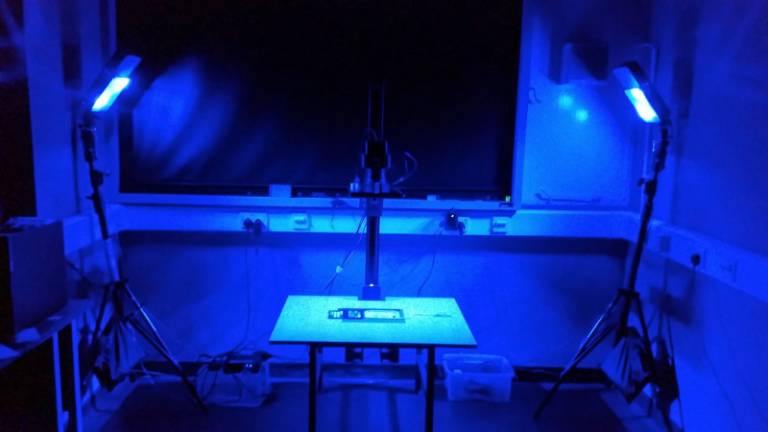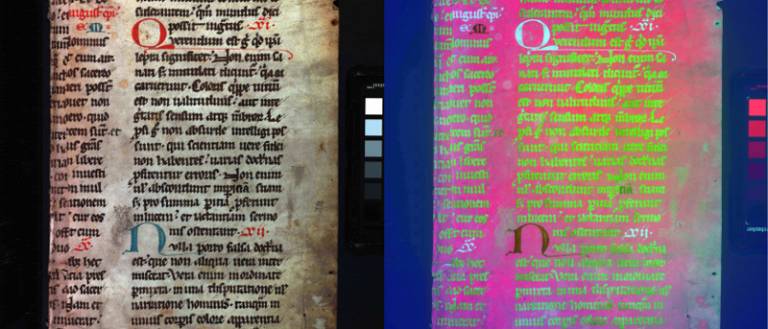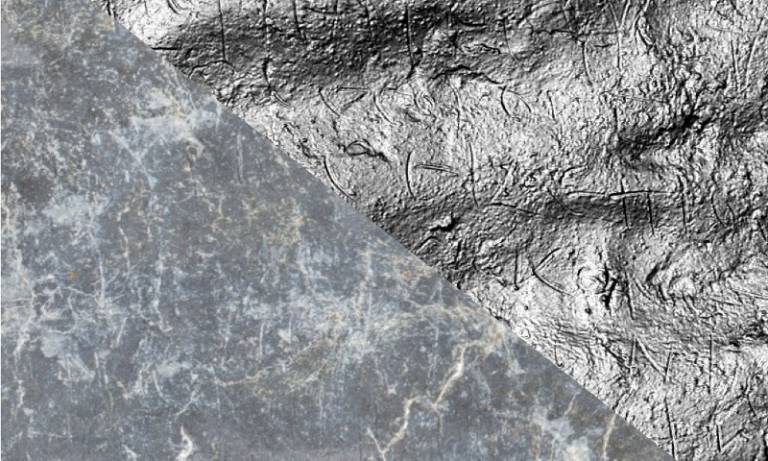UCL Advanced Imaging Consultants (UCLAiC) provide specialist imaging services and training for academic and private institutions, companies, heritage professionals, researchers and students.
We work closely with UCL Digital Media Services, who provide conventional Photography Services and standard 2D digitisation services. Using the latest digital imaging technology we currently offer:
#Spectral Imaging
#Reflectance Transformation Imaging (RTI)
The kinds of material that are suitable for specialist imaging include:
- Documents, manuscripts, maps
- Artworks and other painted objects
- Coins, medals, jewellery
- Other objects bearing fine details such as seals and impressed sealings, cuneiform tablets, as well as inscriptions, carvings, bas-reliefs
- Forensic evidence or any object/surface requiring detailed examination
We are trained in museum handling and work closely with heritage professionals to ensure the safety of objects whilst they are being imaged.
Specialist photography takes place in the UCL Multi-Modal Digitisation Suite on UCL's main campus on Gower Street. Selected imaging can be done on location.

Spectral Imaging system, UCL Multi-Modal Digitisation Suite
Spectral Imaging
Spectral Imaging is a high-resolution, non-invasive and non-destructive form of computational photography. Spectral Imaging extends conventional photography from the red, green, and blue regions of the electromagnetic spectrum to the ultraviolet and infrared wavelengths. The acquired image set is digitally processed to disclose features of the object that are invisible to the naked eye in natural light. This technique can enhance faded writings, reveal palimpsest and under-drawings, as well as aid pigments, binders and other materials identification. Spectral imaging helps clarify and support research, scholarly and other goals.

Manuscript detail (Latin 4, folio 1, verso). Left: RGB image; Right: Multispectral false colour image. Courtesy UCL Library Special Collections
With our system (supplied by R. B. Toth Associates), a medium-format, 60-megapixel PhaseOne IQ260 Achromatic camera takes a series of high-quality digital images. Illumination is provided by low heat, narrowband light emitting diodes (LED) at 12 different wavelengths from ultraviolet to near infrared, with the application of a 6-position motorised filter wheel (developed and integrated by Dr. Bill Christens-Barry of Equipoise Imaging). Post-processing techniques are applied to visually enhance features of significance with outputs being customised to meet your research or other needs.
The UCL state-of-the-technology spectral imaging system can be applied to documents and manuscripts, polychrome artworks, and a range of archaeological and heritage objects. This powerful imaging method offers new opportunities for cultural heritage studies into the unique objects in museum, library and personal collections. Files are delivered in conventional file formats (TIFF, JPEG) and therefore do not require special software for viewing.
Reflectance Transformation Imaging
We offer both custom RTI services and training. Reflectance Transformation Imaging (RTI), also known as Polynomial Texture Mapping (PTM), is a high-resolution, non-invasive and non-destructive imaging technique for documenting fine surface details. Unlike conventional photographs, images created using the RTI capture method can be virtually relit. The direction of the light source can be moved around in real time to give 3D appearance to surface shapes for systematic inspection of fine surface details.

Detail of Greek-inscribed lead tablet (T37, Institut für Altertumskunde). Left: default lighting; Right: specular enhancement. Images: Kathryn E. Piquette. Courtesy University of Cologne.
We capture a series of photographs of an artefact or other material surface with a high-resolution full-frame DSLR camera and macro lens, with light systematically applied from a different position in each shot. These multiple captures are amalgamated using mathematical algorithms to create an image of the surface that can be virtually relit and enhanced to reveal fine surface details. RTI data provide a super high resolution, archival record of material surfaces.
Files are easy to view and disseminate thanks to free, open access software that is powerful yet intuitive. In addition to virtual relighting, visualisation is enhanced by increasing the level of zoom and applying rendering modes that mathematically enhance surface shape and colour attributes (e.g. specular enhancement, diffuse gain). These enhancements disclose faint marks and surface information not readily apparent under the conditions of first-hand observation. Such capabilities make RTI a powerful documentation and analytical tool for material culture while facilitating accessibility and dissemination. We follow the RTI capture and metadata standards established by domain leaders Cultural Heritage Imaging (CHI).
The UCLAiC Team
- Melissa Terras
- Melissa Terras is Honorary Professor at UCL Centre for Digital Humanities (now Professor of Digital Cultural Heritage at the University of Edinburgh) and provides expertise in non-destructive digital imaging technologies and computational methods to make obscured texts visible.
- Adam Gibson
- Adam Gibson is Professor of Medical Physics (UCL Medical Physics and Biomedical Engineering) and also Research Associate at UCL Centre for Digital Humanities. He brings his extensive experience in multimodality medical imaging techniques to bear on solutions for the recovery of lost text in historical documents.
- Kathryn E. Piquette
- Dr Kathryn E. Piquette (UCL Centre for Digital Humanities) is responsible for providing our Reflectance Transformation Imaging, Spectral Imaging, and other digitisation services. Kathryn has more than 10 years of experience in heritage imaging, including a wider variety of portable and fixed museum objects, and library and archive materials. As an Egyptologist and active field archaeologist, Kathryn understands imaging requirements from research, conservation, teaching and general interest perspectives, and how to combine these requirements with the appropriate imaging solution.
- Tim Weyrich
- Tim Weyrich is Professor of Visual Computing (UCL Computer Science) and Deputy Director of the UCL Centre for Digital Humanities. He has a long-standing track record in putting his background in appearance modelling, 3D reconstruction and multi-modal imaging to the service of computational reconstruction and analysis of heritage objects.
 Close
Close

